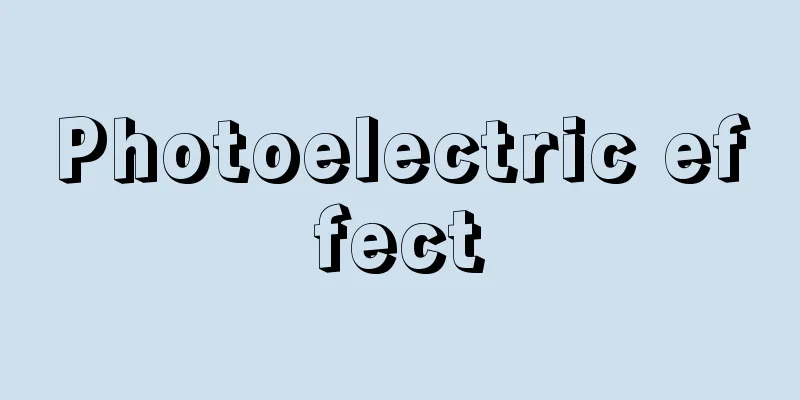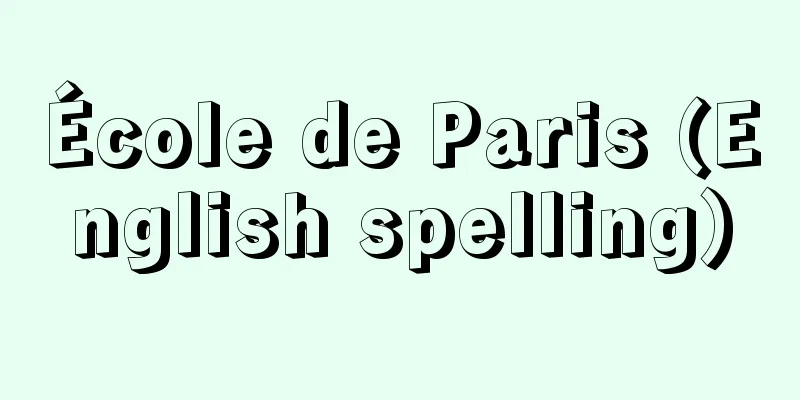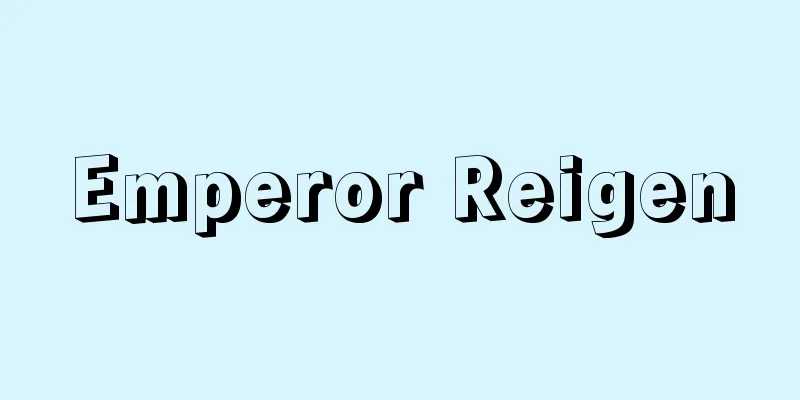Photoelectric effect

|
When light is shone on the surface of a solid such as a metal, the light is absorbed and electrons are emitted from the surface. This phenomenon is called the photoelectric effect or, more specifically, the external photoelectric effect. The free electrons emitted are called photoelectrons, and the electron flow is called photocurrent. Photoionization, in which gas atoms or molecules absorb light and emit photoelectrons to become ions, is also a phenomenon of the photoelectric effect. When light is shone on the metal cathode plate of a two-electrode vacuum tube with opposing metal plates, the needle of an ammeter deflects. According to the experiment, (1) the maximum kinetic energy of the emitted photoelectrons changes linearly with the frequency ν of the irradiating light. (2) When ν is smaller than a limit value determined by the material, photoelectrons are not emitted. (3) The number of photoelectrons emitted increases in proportion to the intensity of the light. However, the maximum kinetic energy of the photoelectrons is not related to the intensity of the light. (4) After irradiation with light, there is no time delay in the emission of photoelectrons. This phenomenon of the photoelectric effect cannot be explained by considering light as a wave. In 1905, Einstein provided a satisfactory explanation, considering light with frequency ν to be a flow of particles with energy h ν ( h is Planck's constant). These particles are called light quanta or photons. When light with frequency ν is absorbed in a material, a light quantum with energy h ν is absorbed, and an electron receives that amount of energy. A certain amount of energy W is required for an electron to escape beyond the surface of a material, and this threshold is called the work function. Therefore, the maximum value of the kinetic energy of an electron escaping from a material is expressed as (1/2) mv 2 = h ν - W (where v is the speed of the photoelectron). By measuring the energy spectrum of photoelectrons emitted by the external photoelectric effect or photoionization, it is possible to determine the electronic and bonding states within solids, atoms, and molecules. This method is called photoelectron spectroscopy. The photoelectric effect is also used in phototubes and photomultipliers. On the other hand, there are internal photoelectric effects called the photoconductive effect and the photovoltaic effect. When light is shone on a semiconductor or insulator, electrons are excited from the valence band to the conduction band, and carriers, electrons and holes, are created in the conduction band and valence band, respectively, increasing the electrical conductivity. This phenomenon is called the photoconductive effect, and is used in infrared detectors and vidicons. Electrons and holes created by light absorption in a semiconductor are separated by a barrier at the interface, generating an electromotive force. This phenomenon is called the photovoltaic effect, and is used in solar cells, etc. When a material is irradiated with short-wavelength light such as gamma rays or X-rays, the energy is transferred to and absorbed by electrons in inner shells such as the K shell and L shell, rather than the electrons in the outer shell, and these electrons are emitted to the outside with different energies. The photoelectric effect due to K shell electrons accounts for about 80% of the total, and in this case, it occurs in proportion to approximately Z 5 /( h ν) 7/2 where Z is the atomic number and h ν is the photon energy. For gamma rays and X-rays below a few hundred kiloelectron volts, absorption by materials is almost entirely due to the photoelectric effect. [Kikuta Seiji] ©Shogakukan "> Photoelectric effect Source: Shogakukan Encyclopedia Nipponica About Encyclopedia Nipponica Information | Legend |
|
金属などの固体表面に光を照射すると、光を吸収してその表面から電子が放出される現象を、光電効果あるいはとくに外部光電効果とよび、放出される自由電子を光電子(こうでんし)、電子流を光電流という。気体の原子や分子が光吸収により光電子を放出しイオンになる光イオン化も、光電効果の現象である。 金属板が相対する2極の真空管において陰極の金属板に光を当てると、電流計の針が振れる。その実験によると、(1)放出される光電子の最大の運動エネルギーは、照射する光の振動数νに対して直線的に変化する。(2)νが物質によって決まった限界値より小さいときには、光電子は放出されない。(3)光の強さに比例して放出される光電子の数は増える。しかし光電子の最大の運動エネルギーは光の強さに関係しない。(4)光照射のあと、光電子の放出に時間的な遅れはない。このような光電効果の現象は、光を波動であるとしては説明できない。アインシュタインは1905年に、振動数νの光はhν(hはプランク定数)のエネルギーをもつ粒子の流れであると考え、満足な説明を与えた。この粒子は光量子または光子とよばれる。物質中に振動数νの光が吸収されるのは、hνのエネルギーをもつ光量子が吸収されることであって、電子がそれだけのエネルギーを受け取る。電子が物質の表面を越えて外に出るには、あるエネルギーWが必要であり、この閾値(しきいち)を仕事関数とよぶ。したがって、物質の外へ飛び出す電子の運動エネルギーの最大値は、(1/2)mv2=hν-W(vは光電子の速さ)によって表される。外部光電効果や光イオン化によって放出される光電子のエネルギースペクトルを測定すれば、固体や原子・分子内の電子状態や結合状態を知ることができる。この方法を光電子分光法という。光電効果はまた光電管や光電子増倍管に利用される。 一方、光(こう)伝導効果と光起電力効果という内部光電効果がある。半導体や絶縁体に光を照射すると、価電子帯から伝導帯へ電子が励起され、キャリアーである電子と正孔がそれぞれ伝導帯と価電子帯に生じ、電気伝導度が増加する。この現象を光伝導効果といい、赤外線検出器やビジコンなどに利用される。半導体で光吸収によりできる電子と正孔が界面の障壁により分離されて起電力を生ずる。この現象を光起電力効果といい、太陽電池などに利用される。 γ(ガンマ)線やX線のような短波長の光によって物質が照射されると、外殻の電子ではなく、K殻、L殻などの内殻の電子にエネルギーを与えて吸収され、それらの電子が光電子としてそれぞれ異なったエネルギーをもって外部に放出される。K殻電子による光電効果が全体の約80%を占めるが、その場合、原子番号Zと光子エネルギーhνに対しておよそZ5/(hν)7/2に比例しておこる。数百キロ電子ボルト以下のγ線やX線では物質による吸収はほとんど光電効果による。 [菊田惺志] ©Shogakukan"> 光電効果 出典 小学館 日本大百科全書(ニッポニカ)日本大百科全書(ニッポニカ)について 情報 | 凡例 |
<<: Imperial College of Education
Recommend
Yorktown (English spelling)
A town on the coast of southeastern Virginia in th...
Ohashi Misono - Ohashi Misono
...Most of the area is mountainous, with the Miya...
Load deformation
…(2) Collapse structure A collapse structure is a...
Ruler - Jogi (English spelling) rule
A drafting tool used to draw straight or curved l...
Industry specialty newspaper - gyokaisenmonshi
...A periodical published within a particular ind...
Italian Credit Bank - Italian Credit Bank
…Official name: Italian RepublicRepubblica Italia...
Russell, R.
...Hotels, theaters, and entertainment facilities...
Itogamodori - The return of the thread
...It has many local names, such as Shimaara in N...
Molasses
1. Sugar molasses. ⇒ Sugar molasses 2. A brown, th...
Mollā Ṣadrā (English spelling)
1571‐1640 A Twelver theologian, philosopher, and m...
petrology
…the science that elucidates the distribution, ge...
froth flotation
...Methods of generating bubbles were also devise...
Iago
A major character in Shakespeare's tragedy &qu...
External audit - Gaibukansa (English spelling) external audit
An audit by a third party independent of a compan...
Mount Kurama
[1] A peak of Kitayama in Sakyo Ward, Kyoto City. ...




![Cape [town] - Misaki](/upload/images/67ccf017f089a.webp)




